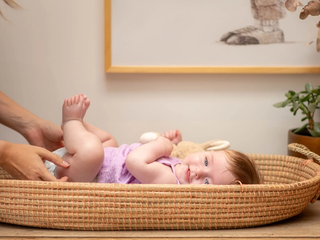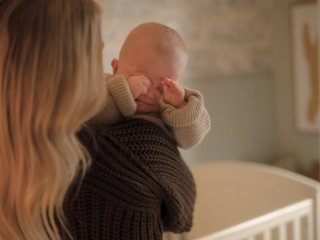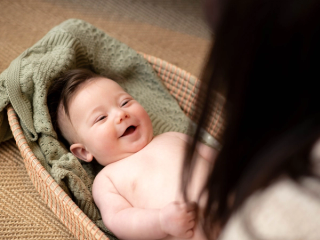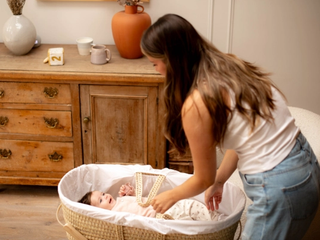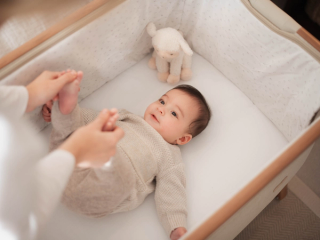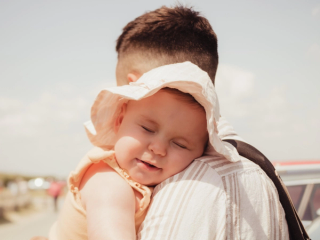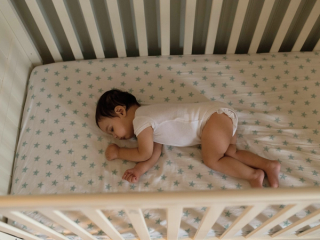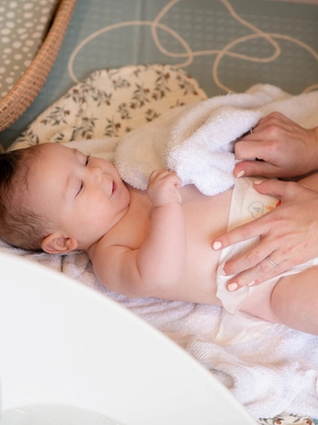
- Home
- Advice Hub
- Newborn
- Essential Newborn Care
- What Causes Nappy Rash And How To Prevent It
What causes nappy rash and how to prevent it
Reviewed by Christine Lane, Midwife and Consultant, on the 24.09.2025
Your baby’s skin is incredibly delicate, and it doesn’t take much to upset its natural balance. With little ones spending around 95% of their day in nappies, it’s no surprise that most babies will experience nappy rash at some stage. Being able to spot the signs early, understand what might be causing it, and knowing how to treat it can make a big difference. In this article, we’ll gently guide you through the common causes, how to help prevent it, and the remedies that can bring your baby relief.
What is a nappy rash?
Nappy rash can creep up on you or appear as if from nowhere – so here are some things to look out for when you’re changing your baby’s nappy:
- Red, raw or sore skin
- Skin that feels hot to the touch
- Signs of discomfort when you touch your little one’s skin, or a wriggliness that suggests itching or pain
- Scaly or dry skin
- Spots or blisters in the nappy area – these might even be weeping.
If any of these symptoms are in play, it’s time to start treating your baby’s skin. Nappy rash can escalate quite quickly and become very painful for your little one, so don’t hesitate to take action. A pharmacist will be able to advise on appropriate treatment or refer you to a GP if needed.
How to prevent nappy rash?
Nappy rash will happen, but you can reduce the frequency and intensity of nappy rash by taking preventive measures. One of the main reasons nappy rash occurs is because babies are all wrapped up in their nappies, and even the most proactive nappy changes can’t prevent skin from coming into contact with their wee and poo – both of which can be quite stringent. That’s why it’s recommended that you follow the ABCDE rule…
Helpful tips – the ABCDE rule
Air
Trapped moisture irritates your baby’s delicate skin and encourages germs to grow, so make sure your baby’s nappy area is thoroughly dry before putting on a clean nappy and give your little one some nappy-free time whenever you can.
Barriers
Even the best nappies can’t whisk away all the wee and poo from your baby’s skin, so coating delicate areas with a layer of barrier cream containing zinc will give an extra bit of protection.
Cleansing
This one’s particularly important, because the longer your baby’s wee and poo are in contact with the skin, the more likely it is to become irritated. Check your baby’s nappy frequently (and we do mean frequently - newborns can wee up to 20 times a day!) and be thorough with the wipes or cotton wool, especially in skin folds where residues can hide. Use alcohol- and fragrance-free wipes (or reusable cloths) to avoid further irritation. Gently pat or blow the skin dry before putting on a clean nappy.
Diapers
(Well, nappies, really.) Choose nappies that have a high absorbency rate, and make sure they fit correctly – you should be able to fit a finger between your baby’s belly and the top of the nappy.
Education
Knowing what causes nappy rash is the first step to preventing it – so congratulations, you’ve already ticked this box!
Nappy rash: what to avoid
If you had sensitive skin, you wouldn’t dream of pouring perfume on it – and the same care should be taken with your baby’s delicate bottom. Fragrance-free and alcohol-free wipes are best to use every time, even when nappy rash isn’t present, to help protect your baby’s natural skin balance
If you’re using reusable wipes, choose a soft, gentle fabric and try to avoid rubbing at sore areas. When things get particularly messy, a warm baby bath can be a kinder option than wiping already tender skin.
When bathing a baby with nappy rash, skip soaps and bubble baths, as they can cause further irritation. And for any creams, be sure to use ones specially made for nappy rash – regular antiseptics, body lotions, or talcum powder aren’t suitable for this sensitive area.
Another common mistake is putting nappies on too tightly, which prevents any air from reaching the area and can exacerbate the rash.
When to ask a pharmacist for advice
Pharmacists are well qualified to offer advice and over-the-counter treatments for mild to moderate cases of nappy rash – with no need to wait on the phone or fill out a form to make an appointment! If your little one’s nappy rash isn’t clearing up or you’re concerned, the pharmacist should be your first port of call.
When to speak to a health visitor, public health nurse or GP
If the nappy rash is particularly painful, or if you notice signs of infection – such as a high temperature – it is time to take your little one to the GP for advice. They can prescribe medicated creams and will also be able to tell if there’s anything else going on, such as thrush (fungal nappy rash), which thrives in warm, moist areas and needs to be treated with anti-fungal medication, or bacterial infection, for which you will need a topical antibiotic.
Common treatments for nappy rash
At home, you can treat (and help prevent) nappy rash with a barrier cream from your local supermarket or pharmacy. These are specially formulated for the nappy area and act – as the name suggests – as a barrier between your baby’s skin and the wee/poo and friction that’s making it sore. Using this cream at every nappy change will help you keep on top of the nappy rash and should stop it from spreading or worsening.
Prescription-based creams and ointments may incorporate steroids such as hydrocortisone in small amounts to reduce swelling, or anti-fungal or anti-bacterial treatments depending on the nature of the infection. These creams should be used according to your doctor’s advice.
What triggers nappy rash?
As mentioned, sensitive skin can become irritated through prolonged exposure to moisture – especially wee or poo – and friction from poorly fitting nappies. However, even fitting a nappy properly and keeping on top of nappy changes can’t wholly prevent nappy rash. Sometimes changes in your baby’s diet, illness, or teething can lead to changes in their poo and wee – or even just greater sensitivity overall – that result in nappy rash. Another trigger could be something in the baby’s bath water, soap or – if you’re using reusable nappies – the washing detergent or soaking solution.
If your baby is suffering, don’t beat yourself up – with the right nappy rash remedies, it will clear up and they’ll soon be back to normal.
Frequently asked questions about nappy rash
One of the best treatments for nappy rash is fresh air, so if your little one is suffering try to give them plenty of nappy free time. Of course, there might be accidents but if the weather’s warm consider letting them kick about outside (on a towel or blanket that’s easy to throw in the wash!) or do the same inside and try to cover surfaces with something washable. After fresh air, the next most important thing is to stay on top of nappy changes, use something gentle to clean them with and slather on that barrier cream to help soothe the rash and prevent it from getting worse.
If you’re not seeing any signs of improvement after a couple of days of this, go to the pharmacist or see your healthcare professional for advice. It might be your little one needs a topical ointment to improve their condition.
If the skin is broken, intensely red or very hot, or your baby’s bottom is covered in swelling blisters, or if you’re seeing no improvements after 2 – 3 days, it’s time to seek medical help. They will likely be very uncomfortable and may need medicated ointment to get rid of the infection. You can also give child-friendly paracetamol to babies over 2 months to help with pain.
Fungal nappy rash is caused by the fungus Candida albicans – the culprit behind yeast infections, otherwise known as thrush. A fungal nappy rash is usually indicated by the presence of blister-filled cysts in the skin folds in the nappy area and it will be uncomfortable. Your little one will need antifungal treatment, which you can get from the doctor or pharmacist.
A nappy rash is usually red and can be raised and swollen, but the presence of pustules (puss-filled blisters) usually indicates something more is going on. If in doubt, pop into the pharmacy with your baby and ask the pharmacist to have a look. They can recommend an appropriate nappy rash treatment.
